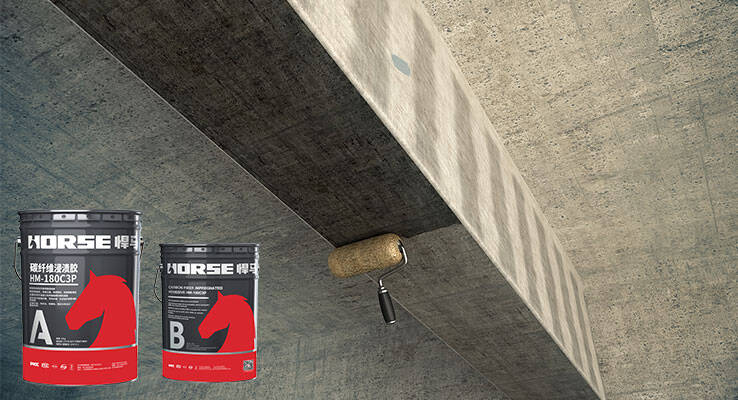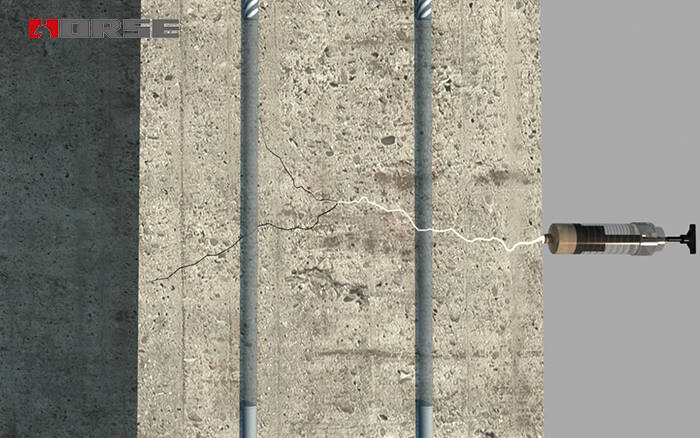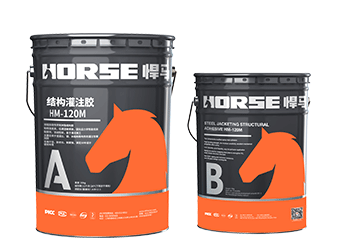Solutions
Horse Construction offers full range of structural strengthening materials with technical supports, documentation supports, products supports, project supports.
concrete structural strengthening materials
Concrete
1. The strength level of concrete used for structural reinforcement should be one level higher than that of the original structure and components, and should not be lower than C20 level.
2. When preparing concrete for structural reinforcement, the type and quality of aggregates should meet the following requirements: The coarse aggregate should be hard, durable crushed stones or pebbles. The maximum particle size: for on-site mixed concrete, it should not be greater than 20mm. For sprayed concrete, it should not be larger than 12mm. For short fiber concrete, it should not be larger than 10mm. Do not use coarse aggregate made of active silica stone.

Fiber and fiber composite
The fibers used in fiber composite materials must be continuous fibers, and their varieties and properties must meet the following requirements:
(1) The ginseng fiber used for the reinforcement of the load-bearing structure must be polypropylene wax-based small tow fiber of 24k or less, and the use of large tow fiber is strictly prohibited;
(2) The glass fiber used for the reinforcement of the load-bearing structure must be high-strength S glass fiber or E glass fiber with an acid content of less than 0.8%, and it is strictly forbidden to use A glass fiber or C glass fiber;
(3) The fiber composite material for structural reinforcement must be composed of continuous fiber and modified epoxy resin cement.
(4) For the on-site bonding and reinforcement of load-bearing structures, it is strictly forbidden to use carbon fiber fabrics with a mass per unit area greater than 600g/m2 or carbon fiber fabrics produced by the prepreg method.
At present, common fiber reinforced composite materials (FRP) mainly include carbon fiber reinforced composite materials (CFRP), aramid fiber reinforced composite materials (AFRP), and glass fiber reinforced composite materials (GFRP). And a hybrid fiber composite material (HFRP) formed by two or more types of fibers reinforced with the same resin matrix.
FRP fiber reinforced composite materials (Fiber Reinforced Plastics) are widely used in the reinforcement and reinforcement of concrete structures, and have received extensive attention from the engineering community. Compared with other materials, FRP has the advantages of high strength, light weight, corrosion resistance and fatigue resistance. Compared with other reinforcement methods, FRP reinforcement technology has the advantages of advanced technology, good performance, does not affect the appearance and use space of the structure, convenient construction, and has the advantages of short cycle, less material consumption, and further reduction in price.
CFRP (Fiber Reinforced Po lymer) carbon fiber composite material is a new high-strength material. The basic principle of strengthening concrete structures is to use modified epoxy resin cementing materials to paste carbon fiber composite materials on the surface of structures or components to form a new composite body. Make the carbon fiber and the original reinforced concrete bear the force together, work together, improve the bending and shear resistance of the structure, and achieve the purpose of strengthening the structural members and improving the force performance.
AFRP aramid fiber sheet (Aramid Fibe Reinforced Plastics) has high tensile, shear and impact resistance, and is soft and easy to bend without shielding and many other advantages. Carbon fiber sheets have irreplaceable application prospects in the seismic reinforcement of subways, bridges, tunnels, houses and other structures.

Adhesives for structural strengthening
1. Adhesives for load-bearing structures should be classified into A-grade adhesives and B-grade adhesives according to their basic properties. Grade A glue is used for important structures, overhanging components, structures and components that bear dynamic action. For general structure, A-grade glue or B-grade glue can be used.
2. The adhesive for impregnating and bonding fiber composite materials must be specially formulated modified epoxy resin adhesive, and its safety inspection must meet the requirements. Unsaturated poly coolers shall not be used in the reinforcement of load-bearing structures. Alkyd resins are used as impregnating and bonding adhesives.

Concrete crack repair material
Chemical grouting reinforcement. Chemical grouting reinforcement is to prepare a certain chemical material into a grout and pour it into the cracks of the concrete structure with a pressure conveying device to spread, gel or solidify to achieve the purpose of reinforcement. There are two main types of chemical grouting materials: one is the epoxy resin grouting material made of epoxy resin as the main agent. It has good chemical stability, can be cured at room temperature, small shrinkage, high strength, and strong adhesion. advantage. And because the cohesive force and cohesive force of epoxy resin grouting material are greater than the cohesive force of concrete, it can effectively repair concrete cracks and restore the integrity of the structure. It is currently a good chemical grouting material for reinforcement and consolidation. The other is a methacrylate grouting material prepared with methyl methacrylate as the main agent. It has the characteristics of good pourability. It can pour into tiny cracks with a width of 0.05mm, and is generally used to repair cracks with a crack width of less than 0.2mm.
Cement grouting reinforcement. Cement grouting reinforcement is a method of using pressure equipment to hydraulically press cement slurry into the honeycombs, holes or cracks of structural members to fill and consolidate these defects to achieve the purpose of reinforcement.
In summary, for the reinforcement of building structures, different reinforcement methods should be adopted according to the actual situation to achieve the best results and meet different requirements.
You can find anything here you are in need of, have a trust trying on these products, you will find the big difference after that.

High strength carbon fiber reinforced polymer (CFRP) strip / laminate / plate for structural strengthening and concrete repair

Modified epoxy resin structural perfusion adhesive, specifically for supporting adhesive bonded steel reinforcement